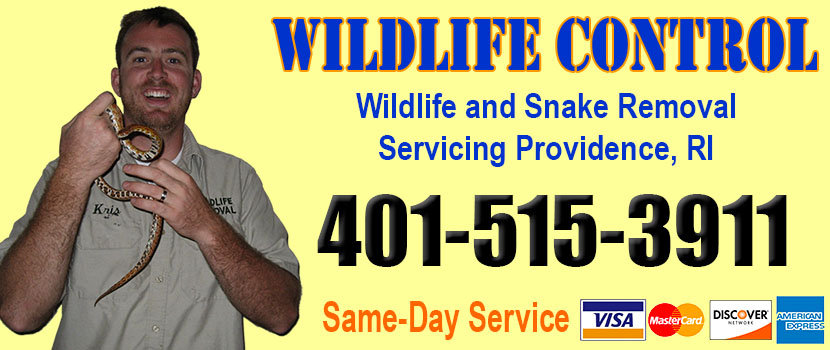
Welcome to providencesnakes.com! I am David, a snake enthusiast living in Providence, RI. Many people don't know that Providence is in fact full of snakes! You just need to know where to find them - they can often be shy and elusive. Some Rhode Island snake species are more common outside of the city limits, in different parts of Providence County RI, but many types of snakes are indeed common in the more urban parts of Providence. This guide is meant to help educate you about the beautiful snakes of Providence, and to help you identify the most common snakes of Providence, as well as the venomous snakes of Providence that you should learn to recognize and avoid. If you want more detail, click here for my complete list of ALL snake species in Providence. Remember the following:
- Most snakes of Providence are harmless and don't want to encounter you
- Venomous snakes exist but are uncommon in Providence, Rhode Island
- Snakes eat rats and mice and are a valuable part of the Rhode Island ecosystem
- Never kill a snake - if you leave a snake alone, it will leave you alone.
Common Snake Species in Providence
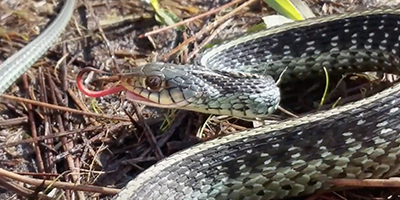 Eastern Garter Snake:
The eastern garter snake (Thamnophis sirtalis) is a widespread species found throughout North America. They like moist, grassy environments but can be found away from water. They can be found in populated areas where there is cover (debris, boards, logs, vegetation). They are not venomous.
Eastern Garter Snake:
The eastern garter snake (Thamnophis sirtalis) is a widespread species found throughout North America. They like moist, grassy environments but can be found away from water. They can be found in populated areas where there is cover (debris, boards, logs, vegetation). They are not venomous. Adult eastern garter snakes are typically 20-28 inches in length. They usually have three yellow longitudinal stripes down a dark body. A few have a checkered pattern with light stripes or reddish body color. They are active both day and night and throughout the year. They are common and not a protected species.
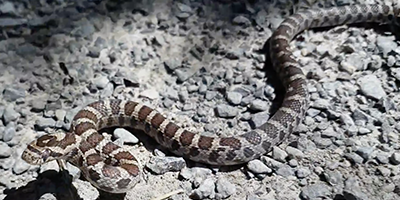 Eastern Milk Snake:
The eastern milk snake (Lampropeltis trangulum) is a nearly universal species that can be found from Canada, throughout much of the United States, and into Mexico and Ecuador. They are typically found in fields, woodlands, and rocky hillsides but like dark places where they can take cover, such as trash piles and basements. They are not venomous and even are kept as pets.
Eastern Milk Snake:
The eastern milk snake (Lampropeltis trangulum) is a nearly universal species that can be found from Canada, throughout much of the United States, and into Mexico and Ecuador. They are typically found in fields, woodlands, and rocky hillsides but like dark places where they can take cover, such as trash piles and basements. They are not venomous and even are kept as pets. Eastern milk snakes have a distinctive pattern of light to reddish-brown bands that are bordered by a thin black line on a gray to light brown to red background. They are often mistaken for the more dangerous copperhead snake. Adult eastern milk snakes average 24 to 52 inches in length. They are primarily nocturnal.
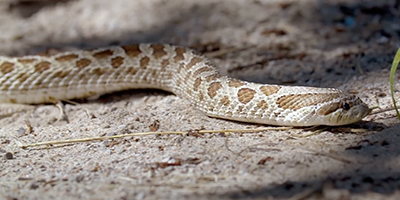 Hognose Snake:
The hognose snake (Heterodon platirhinos) is a common species of snake in the United States that can be found from as far north as southern Minnesota and New Hampshire, to Kanas, and as far south as Florida and Texas. They like areas with sandy soil and woodlands. In urban settings, it is attracted to piles of debris and construction sites with exposed soil. They prey mainly on amphibians, such as toads, and have fangs with an amphibian-specific venom that is not deadly or even harmful to humans. They are considered non-venomous.
Hognose Snake:
The hognose snake (Heterodon platirhinos) is a common species of snake in the United States that can be found from as far north as southern Minnesota and New Hampshire, to Kanas, and as far south as Florida and Texas. They like areas with sandy soil and woodlands. In urban settings, it is attracted to piles of debris and construction sites with exposed soil. They prey mainly on amphibians, such as toads, and have fangs with an amphibian-specific venom that is not deadly or even harmful to humans. They are considered non-venomous.The hognose snake gets its name from its most distinctive feature- an upturned nose that is useful for digging in sandy soil. They come in a wide variety of colors and can be a mix of red, green, orange, brown, yellow, grey, or black. They also have a wide variety of markings. They tend to have lighter bellies that are tan, cream-colored, or grey. The average adult is 28 inches and females tend to be larger than males.
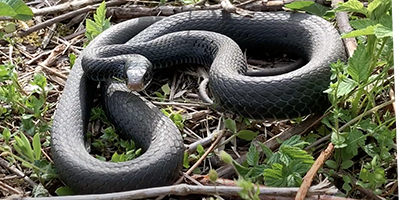 Northern Black Racer:
The northern black racer (Coluber C. Constrictor) is a common snake that is found from southern Maine down the eastern seaboard to Georgia, and west in Ohio down through Alabama and parts of Tennessee. It shows a preference for lightly wooded habitats, including meadows, fields, powerline rights-of-way, and the transitional spaces between forests and fields. They are not venomous.
Northern Black Racer:
The northern black racer (Coluber C. Constrictor) is a common snake that is found from southern Maine down the eastern seaboard to Georgia, and west in Ohio down through Alabama and parts of Tennessee. It shows a preference for lightly wooded habitats, including meadows, fields, powerline rights-of-way, and the transitional spaces between forests and fields. They are not venomous.The adult northern black racer has a solid black coloring with smooth scales that give it a dramatic “matte” finish. It has a white chin and a blue-tinged belly. Juveniles have a light-grey body with dark-brown blotches that darken with age. Adults can range in length from 33 to 65 inches. They hunt in the daytime and prey on toads, frogs, small birds, small mammals (like chipmunks and shrews), rodents, and insects.
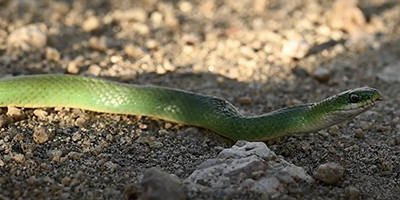 Smooth Green Snake:
The smooth green snake (Opheodrys Vernalis) is a common snake that is found in a large geographic area of southern Canada, and throughout the eastern seaboard of the United States down to Virginia, as well as west to Wyoming, Colorado, Kansas, Mississippi, Texas, and down to northern Mexico. It makes its home in habitats such as marshes, meadows, open woods, and streams. It is particularly fond of open areas. They are not venomous.
Smooth Green Snake:
The smooth green snake (Opheodrys Vernalis) is a common snake that is found in a large geographic area of southern Canada, and throughout the eastern seaboard of the United States down to Virginia, as well as west to Wyoming, Colorado, Kansas, Mississippi, Texas, and down to northern Mexico. It makes its home in habitats such as marshes, meadows, open woods, and streams. It is particularly fond of open areas. They are not venomous. The smooth green snake lives up to its name, being thin, with smooth green scales. It is bright green with a yellow or white belly. Juveniles are typically olive-green, blue-grey, or brown until they shed their skin and take on the characteristic bright green. They enjoy eating insects, spiders, ants, moths, snails, slugs, and caterpillars. Their habitat is threatened by human activities such as farming, logging, off-road vehicles, pesticide use, and residential development.
If you're unsure, you can email me a photo of the snake at info@providencesnakes.com and I will email you back with the snake's species. If you found a snake skin, read my Found a Skin? page, and you can email me a photo of the skin, and I'll identify the snake for you. If you need professional Providence snake removal help, click my Get Help page, or see the below website sponsor I found, who provides that service.
Is it Illegal to Kill Snakes?
If you encounter a snake on your property, you are probably wondering if it is lawful or unlawful to kill the snake. As of now, there are federal and state laws that are protecting these animals. If you live in a snake-prone area, knowing these laws may help you avoid any legal repercussions like hefty fines and imprisonment. Additionally, if you are hiring a snake removal expert, it is the homeowner's responsibility to ensure that everything is according to the existing rules. Otherwise, you can be dealing with a lawsuit.
What Are the Laws the Protect Snakes?
Snakes that belong in the list of threatened species are protected under the ESA (Endangered Species Act of 1973). Therefore, killing these snakes would be unlawful. For those that are not endangered, each state has a regulation on hunting them. They also categorized snakes as non-game animals. The law may vary depending on the state where you live. The ESA includes about 1,600 species of animals and plants that are highly likely to become extinct. Some of the snakes that are included in the federal list are several subspecies of garter snakes, eastern Massasauga rattlesnake, Lake Erie Watersnake, Louisiana Pine Snake, and Indigo Snakes.
How Much is The Fine on Killing Snakes?
Failure to comply with the ESA of 1973 entails a maximum fine of about $50,000 and at least one year of imprisonment. The fine may increase if you have broken a state law; if the authority has caught you, the fine can be around a couple of hundred dollars. For instance, if you live in Maryland, they probably have the stringiest law on killing snakes. Last 2015, a group of men received a $500 fine for killing the rattlesnake.
What Are Some State Laws That Protect Snakes?
While the federal is imposing a clear law on the illegal killing of snakes, the state law may vary unpredictably. It is applied even in Alaska, where the snakes will find it impossible to survive. In Alabama, most of the snakes are unprotected by the law. However, it is still unlawful to kill, capture, sell, or trade some snakes like a southern hognose snake, Florida Pine snake, Eastern Indigo Snake, Black Pine Snake, etc. In Arkansas, you are not allowed to kill any species of snake unless they are imposing an immediate threat to your safety and health. In Colorado, you are permitted to kill a rattlesnake only if it poses a risk to your property and life.
Apart from the laws that protect them, the methods you may use are also specified under the law. For instance, you may not be allowed to use a gun, especially in residential communities. They may also specify the caliber of firearms that you may use. Some states limit the use of poison and toxic substances. Therefore, if you discover a snake on your property, and you have no idea if it is protected under the law, it is better to ask the professionals to stay away from any fines and punishments.
Remember, the term is not poisonous snakes of Providence, it's venomous snakes of Providence. Poison is generally something you eat, and venom is injected into you. That said, dangerous snakes are very rare in Providence. The few venomous snakes of Providence County are rarely seen. But they are commonly misidentified, so learn about all the snake species of Providence in order to correctly identify them. These snakes are usually also found in the surrounding towns of Providence, East Providence, Pawtucket, Cranston, North Providence, Woonsocket, Smithfield, Johnston, Lincoln, Central Falls, Cumberland, North Smithfield, Scituate, Burrillville, Glocester, Foster, and the surrounding areas.
Read our article about:
How to Get the Snakes Out of the Wall?
providencesnakes.com domain and hosting costs made possible by the generous support of this sponsor:
